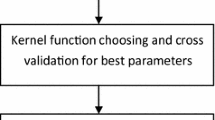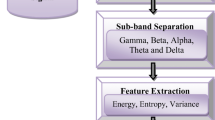Abstract
This paper presents an application of a radial basis support vector machine (RB-SVM) to the recognition of the sleep spindles (SSs) in electroencephalographic (EEG) signal. The proposed system comprises of two stages. In the first stage, for feature extraction, a set of raw amplitude values, a set of discrete cosine transform (DCT) coefficients, a set of discrete wavelet transform (DWT) approximation coefficients and a set of adaptive autoregressive (AAR) parameters are calculated and extracted from signals separately as four different sets of feature vectors. Thus, four different feature vectors for the same data are comparatively examined. In the second stage, these features are then selected by a modified adaptive feature selection method based on sensitivity analysis, which mainly supports input dimension reduction via selecting the most significant feature elements. Then, the feature vectors are classified by a support vector machine (SVM) classifier, which is relatively new and powerful technique for solving supervised binary classification problems due to it’s generalization ability. Visual evaluation, by two electroencephalographers (EEGers), of 19 channel EEG records of six subjects showed that the best performance is obtained with an RB-SVM providing an average sensitivity of 97.7%, an average specificity of 97.4% and an average accuracy of 97.5%.








Similar content being viewed by others
References
Dijk DJ, Hayes B, Czester CA (1993) Dynamics of electroencephalographic sleep spindles and slow wave activity in men: effect of sleep deprivation. Brain Res 26:190–199
Hasan J (1996) Past and future of computer-assisted sleep analysis and drowsiness assessment. J Clin Neurophysiol 13:295–313
Kubichi S, Herrman WM (1996) The future of computer-assisted investigation of the polysomnogram: sleep microstructure. J Clin Neurophysiol 13:285–294
Rechtshaffen A, Kales A (1968) A manual of standardized terminology, techniques, and scoring system for sleep stages of human subjects. US Public Health Service, US Government Printing Office, Washington, DC
Jankel WR, Niedermeyer E (1985) Sleep spindles. J Clin Neurophysiol 2:1–35
Wei HG, Riel E, Czeisler CA, Dijk DJ (1999) Attenuated amplitude of circadian and sleep-dependent modulation of electroencephalographic sleep spindle characteristics in elderly human subjects. Neurosci Lett 260:29–32
Steriade M (1993) Cellular substrates of brain rhythms. In: Niedermeyer E, Lopes da Silva F (eds) Electroencephalography: basic principles, clinical applications and related fields, 3rd edn. Williams & Wilkins, Baltimore, Maryland, pp 27–62
Crowley K, Trinder J, Kim Y, Carrington M, Colrain IM (2002) The effects of normal aging on sleep spindle and K-complex production. Clin Neurophysiol 113:1615–1622
Declerck AC, Martens WL, Wauquier W (1986) Sleep spindle detection and its clinical relevance. Eur Neurol 25:56–60
Gaillard JM, Blois R (1981) Spindle density in sleep of normal subjects. Sleep 4:385–391
Principe JC, Smith JR (1982) Sleep spindle characteristics as a function of age. Sleep 5:73–84
Fish DR, Allen PJ, Blackie JD (1988) A new method for the quantitative analysis of sleep spindles during continuous overnight EEG recordings. J Sleep Res 70:273–277
Schimicek P, Zeitlhofer J, Anderer P, Saletu B (1994) Automatic sleep spindle detection procedure: aspects of reliability and validity. Clin Electroencephalogr 25:26–29
Huupponen E, Varri A, Hasan J, Himanen SL, Lehtokangas M, Saarinen J (1999) Fuzzy reasoning based sleep spindle detection. In: Proceedings of the 1999 Finnish signal processing symposium, Oulu, Finland, May 1999, pp 94–97
Smith JR (1975) Detection of human sleep EEG waveforms. Electroencep Clin Neurophysiol 38:435–437
Kumar A, Hofman W, Campbell K (1979) An automatic spindle analysis and detection system based on the evaluation of human ratings of the spindle quality. Waking Sleeping 3:325–333
Vapnik V, Golowich S, Smola A (1997) Support vector method for function approximation, regression estimation, and signal processing. In: Advances in neural information processing systems 9. MIT Press, Cambridge, pp 281–287
Boser B, Guyon I, Vapnik V (1992) A training algorithm for optimal margin classifiers. In: Proceedings of the 5th annual ACM workshop on computational learning theory (COLT’92), Pittsburgh, Pennsylvania, July 1992. ACM press, New York, pp 144–152
Haykin S (1999) Neural networks: a comprehensive foundation. Prentice Hall, Englewood Cliffs, New Jersey
Bertsekas DP (1995) Nonlinear programming. Athenas Scientific, Belmont, Massachusetts
Zurada JM, Malinowski A, Usui S (1997) Perturbation method for deleting redundant inputs of perceptron networks. Neurocomputing 14:177–193
Belue LM, Bauer KW Jr (1995) Determining input features for multilayer perceptrons. Neurocomputing 7:111–121
Steppe JM, Bauer KW Jr (1997) Feature saliency measures. Comput Math Appl 23(8):109–126
Daubechies I (1992) Ten lectures on wavelets. Capital City Press, Montpelier, Vermont
Akay M (1994) Biomedical signal processing. Academic Press, San Diego, California
Haykin S (1996) Adaptive filter theory. Prentice Hall, Englewood Cliffs, New Jersey
McNeil BJ, Keeler E, Adelstein SJ (1975) Primer on certain elements of medical decision making. N Engl J Med 293:211–215
Acır N, Öztura Í, Kuntalp M, Baklan B, Güzeliş C (2003) Automatic spike detection in EEG by a two-stage procedure based on artificial neural networks. In: Proceedings of the 13th international conference on artificial neural networks (ICANN) and the 10th international conference on neural information processing (ICONIP), Ístanbul, Turkey, June 2003, pp 445–448
Acknowledgements
The first author, Nurettin Acır, would like to thank TÜBÍTAK (Turkish Scientific and Technical Research Council) Münir Birsel Fund for the financial support as a scholar, and also special thanks to Dr. Özcan Özdamar for his valuable supports to Mr. Acır’s studies at the Neuro-Sensory Engineering Laboratory, University of Miami, USA.
Author information
Authors and Affiliations
Corresponding author
Rights and permissions
About this article
Cite this article
Acır, N., Güzeliş, C. Automatic recognition of sleep spindles in EEG via radial basis support vector machine based on a modified feature selection algorithm. Neural Comput & Applic 14, 56–65 (2005). https://doi.org/10.1007/s00521-004-0442-z
Received:
Accepted:
Published:
Issue Date:
DOI: https://doi.org/10.1007/s00521-004-0442-z




